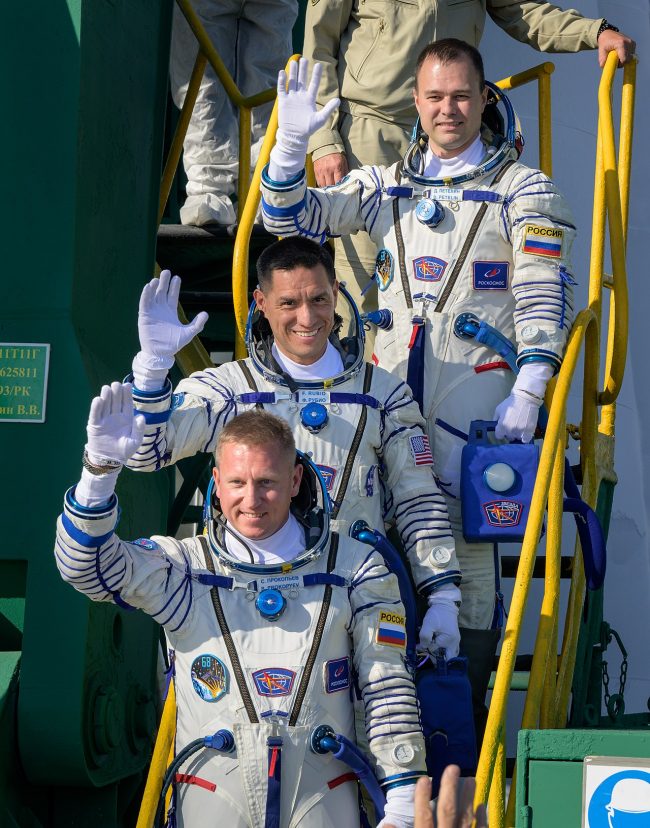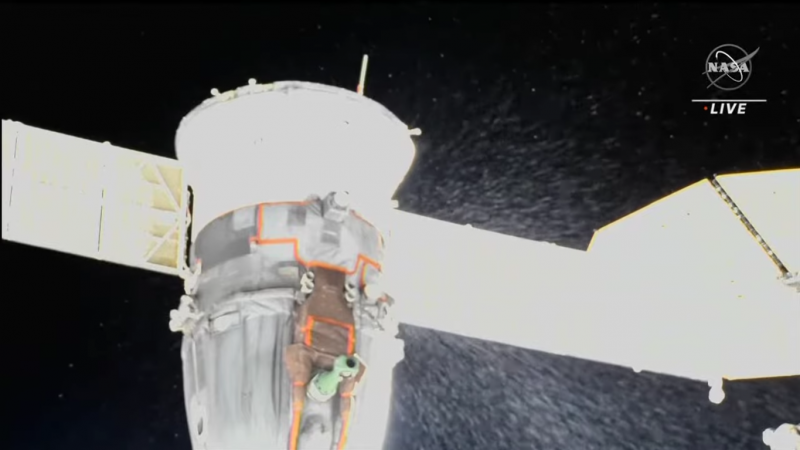
Stranded ISS crew (sort of)
Russia launched an uncrewed Soyuz to the International Space Station (ISS) on Friday, February 24, 2023. This Soyuz (MS-23) is a replacement for Soyuz MS-22, which sprang a very visible coolant leak in December. It had successfully delivered three astronauts to the ISS in September 2022 before getting hit with a micrometeoroid while docked at the space station. Since then, the space travelers – Russian cosmonauts Sergey Prokopyev and Dmitri Petelin, and U.S. astronaut Frank Rubio – have been aboard ISS without a designated ship to get home.
Their new ride – Soyuz MS-23 – docked successfully at 7:58 p.m. ET Saturday, February 25 (00:58 UTC on Sunday, February 26) at the ISS’s Poisk module. It didn’t arrive empty-handed. The uncrewed capsule carried 946 pounds (429 kg) of supplies. NASA reported the leaky spacecraft will return to Earth for inspection:
The damaged Soyuz MS-22 is scheduled to undock from the station in late March and return to Earth for an uncrewed parachute-assisted landing in Kazakhstan, and post-flight analysis by Roscosmos.
The crew’s mission was supposed to end in March. Now, the astronauts will remain onboard until September, even once they receive the new Soyuz at the ISS. Space.com reported that the reason they are extending their stay in orbit an extra six months is that:
… the next Soyuz [the Soyuz that launched Friday] will stay docked at the ISS until its successor – a vehicle that will carry crew – is ready to go.
Last chance to get a moon phase calendar! Only a few left.

The ‘rescue’ mission for stranded ISS crew
Roscosmos had been planning to send up another uncrewed ship to the ISS for the “stranded” crew to return home in. (Other vessels currently docked at ISS could squeeze them in with the four other crew members currently at ISS, but that option isn’t ideal).
Roscosmos officially declared the date of the uncrewed ship launch official this past Monday (February 20), when the Russian state news agency TASS reported that the State Commission formally granted a permit for launch.
The Soyuz MS-23 successfully launched from Russia in the early hours of Friday, February 24, which was Thursday evening, February 23 in the Western Hemisphere.
Unpiloted Soyuz MS-23 lifts off from Baikonur: https://t.co/5dSoResuiy pic.twitter.com/gdJMc26Ngd
— Anatoly Zak (@RussianSpaceWeb) February 24, 2023
The Soyuz MS-23 launch was originally scheduled for February 20, but faced a delay due to a second leaky spacecraft.
A 2nd leak, in a 2nd craft
In February, Roscosmos detected a second spacecraft docked at the ISS was also leaking. This second spacecraft is a supply ship named Progress 82 and known as Progress MS-21 to the Russians. The supply ship launched back on October 28, 2022, and reached the ISS without incident and docked successfully.
After discovering the leak on February 11, engineers undocked Progress 82 from the ISS on February 18. They took photos to inspect the craft. Then, loaded with trash, Progress 82 fired its engine to de-orbit. Less than an hour later, it impacted in the Southern Pacific Ocean. (This area is nicknamed the spacecraft cemetery, because it is an uninhabited area targeted for re-entry of spacecraft such as the former Mir space station.)
Micrometeoroids likely cause of leaks
Roscosmos believes the sources of both leaks are tiny bits of rock and other material in space (micrometeoroids). On February 21, Anatoly Zak at RussianSpaceWeb.com reported that Roscosmos said:
Based on the preliminary assessment of the situation with Progress MS-21 at RKK Energia, the cargo ship had experienced an external impact … This conclusion was made based the photos which revealed changes on the exterior of the vehicle … the holes discovered (on the photos after undocking) had not been seen either during the manufacturing of the Progress MS-21 at the factory, nor during its preparation for launch, nor during its flight and docking with the ISS.
Despite two recent leaks due to possible micrometeoroid strikes, all sources agree that the likelihood of another impact to the soon-to-launch Soyuz MS-23 is low.
"External impact" blamed for coolant loss (…again, this time on the Progress MS-21 cargo ship).
DETAILS: https://t.co/QA5zHmYE03 pic.twitter.com/h7GWfWPJuJ— Anatoly Zak (@RussianSpaceWeb) February 21, 2023
Bottom line: On Friday, February 24, 2023, Russia successfully launched a replacement Soyuz spacecraft for the stranded ISS crew to eventually ride home in.











